PGA Tour Grip Styles Part 2 Continued
- by Kelvin Miyahira
How do we achieve a better impact position?
In the ‘80’s former tour player John Schlee, who had conversations with Ben Hogan about the swing, recommended what he thought was the best way to get into Hogan’s bowed wrist at impact by starting at address in that position and returning to it at impact.
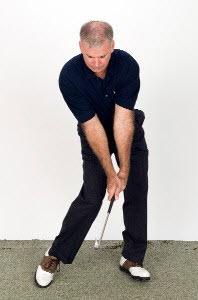
Here’s a picture of the address/grip position he recommends from his website.

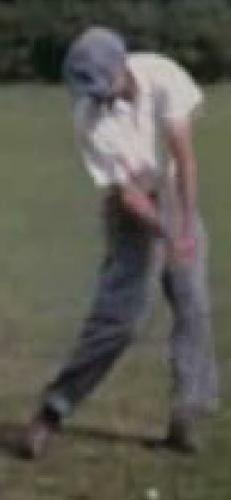
But Hogan did not start in Schlee’s postion yet found his way to a great impact position. So should we copy Hogan or the teacher’s interpretation?
George Costanza’s Rule
Maybe George was right. Whatever your instincts are, do the opposite and you’ll be correct.

So if we want to achieve Trevor Immelman’s position at impact how would George do it? Let’s start by detailing these positions.
The left forearm/wrist/hand movement/positions are:
- Forearm supination
- Wrist flexion
- Ulnar deviation
- The right forearm/wrist/hand positions are:
- Forearm pronation
- Wrist extension
- Ulnar deviation
The genius of George would say, “Since my first instinct would be to start in all of these positions like Schlee, I’ll do the opposite! So let’s start in the opposites of all these positions.”
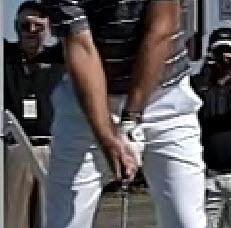
Too late George. The PGA tour guys have already figured this out. Here’s Trevor Immelman with a standard strong grip.
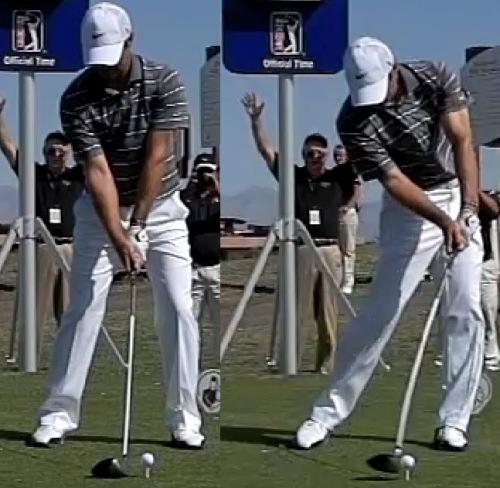
Do you see the opposite positions? So how does he get to impact without the clubface being massively closed while doing all these moves?
Clubfaceology
Just as important as the swing plane, one’s clubface orientation will influence how your hands/arms will move. So let’s take a closer look at Trevor’s clubface positions to understand hands/arms movements needed to square the clubface with a great impact position.
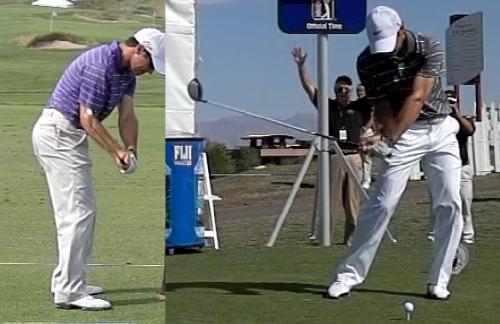
About halfway down Trevor still has his left wrist slightly cupped. The clubface is open to the plane.
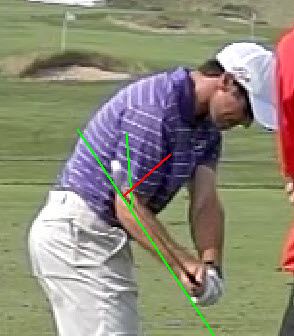
<<G761.JPG>>
The red line depicts where the clubface would need to be if square to the plane. Thus at this point, the clubface is at least 45-50 degrees open to the plane. But wait a minute, how did the clubface get open?
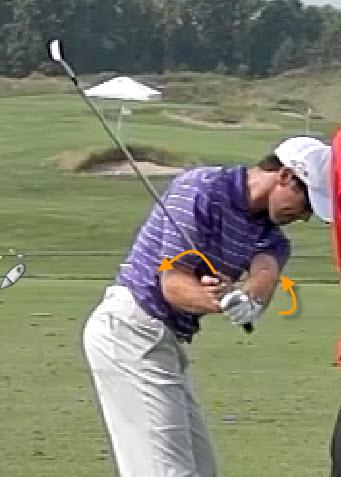
We must not forget that there is left arm internal rotation and right shoulder external rotation that occurs during the backswing and transition.
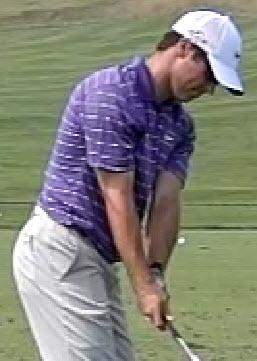
Trevor’s left elbow is pointing down on the takeaway.
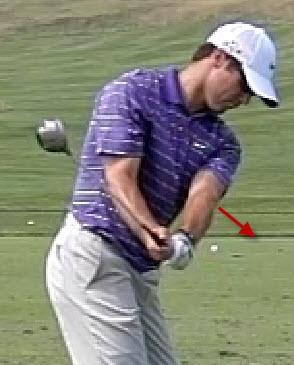
Starts to internally rotate the left shoulder.
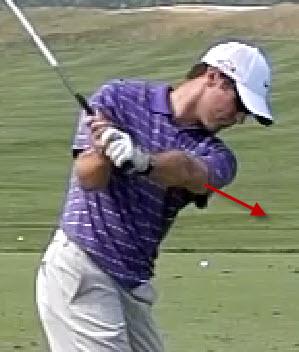
By this point, his left elbow is pointed almost horizontal.
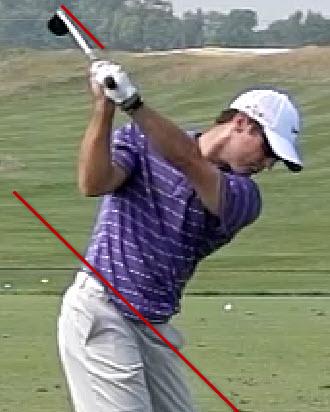
At the top of his backswing, you can see the effect this has on the clubface as it is now parallel to his plane.
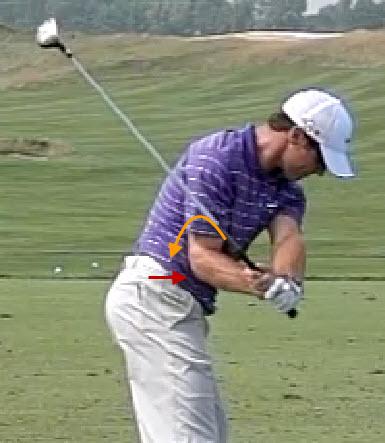
Then the right shoulder is externally rotating (orange curved arrow direction) to drop the club onto the flatter downswing plane and move the right elbow in front of his hip (red line). This would open the clubface even more if he were not counteracting with right forearm pronation or what I call the “stop sign move.”
Thus, the question of why the clubface is not massively closed at impact despite left forearm supination and right forearm pronation should be very clear. The range of motion of the internal rotation of the left shoulder is around 90 degrees for most people (this assumes that you start in a neutral position). This means the amount of clubface opening rotation during the backswing/start of downswing due to Left Shoulder Internal Rotation/Right Shoulder External Rotation is going to be somewhere around 90 degrees.
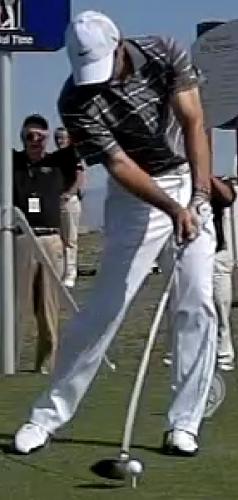
Add in that Trevor’s hands are about 15 degrees ahead at impact and now you’ve got to close the clubface even more to return to square with that much shaft lean.
Weak Grip Changes Shoulder Position at Address
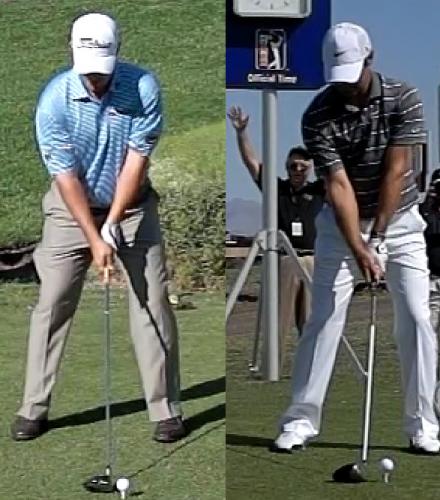
Notice the elbow position is different for the weak grip versus the strong grip. Johnson’s left elbow points back more toward his hip as Hogan said whereas Trevor has his elbow pointed more toward the target. Thus Johnson has his left shoulder externally rotated at address and has even more range of motion to move toward internal rotation. In other words, Johnson’s left shoulder is rotated about 30 degrees more in the counter-clockwise direction.
Then look at Johnson’s right elbow. It is pointed away from the target whereas Trevor’s is pointed toward his hip. So Johnson has his right shoulder slightly internally rotated which is going to give him more range of motion to move to external rotation which occurs in the backswing/transition and ultimately affect the clubface angle to be more open than Trevor’s. Conversely, Trevor starts close to a fully externally rotated position with his right shoulder. This has the effect of reducing the amount of clubface opening due to movements in backswing/transition.

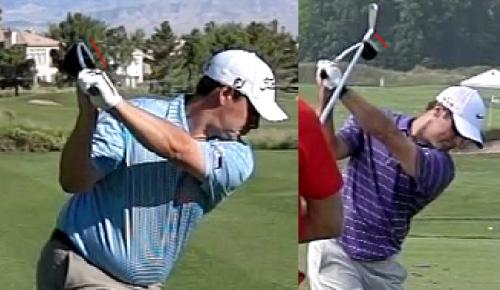
Thus the clubface opening potential is greater for Johnson than Trevor and it appears in the top of the backswing position. This means he’ll need more clubface rotation to square the clubface at impact. Not that there’s anything wrong with that...
But this is the challenge for those with weak/neutral grips and while it is possible for some of the tour pros to deliver the club in a good position with a weak/neutral grip, they are in the minority.
The Closing Options
Closing the clubface or returning the clubface to square with some forward shaft lean WHILE drive/holding through impact is the goal.
There are several options to choose from and while none of these methods truly exists in isolation, they will be classified by the dominant movements. Thus the choices are:
- Left forearm supination and right forearm pronation (LFS/RFP)
- Left wrist extension/right wrist flexion (LWE/RWF)
- Left shoulder external rotation
Or
- Combination #1 - left shoulder external rotation with LWE/RWF
- Combination #2– left shoulder external rotation with LFS/RFP
- Combination #3 - LFS/RFP with LWE/RWF
- Mixed Plate – blend of all three movements
Of course, the more complex your clubface squaring pattern is, the more difficult it will be to consistently repeat it.
Left Forearm Supination/Right Forearm Pronation
Here’s how Trevor and most of the PGA tour players with strong grips accomplish this goal.

So let’s go back to where the shaft is about 9:30 and the clubface looks to be “toe up” and at least 45-50 degrees open to the plane at this point.
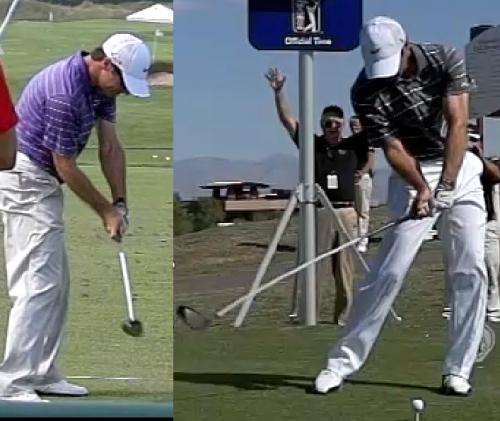
At this position, Trevor has supinated the left wrist so that it is now flat. The clubface has moved closer to square however is still not square to the plane.
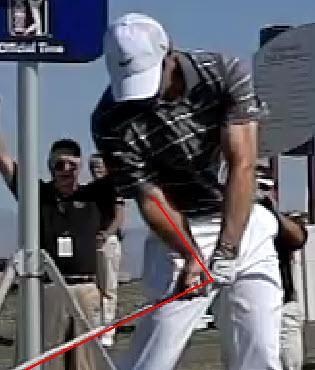
His right wrist remains in extension judging by the angle of his right forearm to the shaft (slight 2D distortion shows a narrower angle than reality).
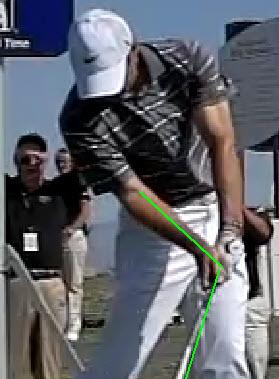
In a nutshell, Trevor squares the clubface with his forearms. The left forearm supinates, left wrist moves into flexion and ulnar deviates while his right forearm pronates, tries to remain in extension (resists moving into flexion) and ulnar deviates. It is the opposite from his grip position at address!!!
Also, he stabilizes the shoulders by remaining in internally rotated in his left arm and externally rotated in the right shoulder.
This is the dominant method used on tour. Whether knowingly or not, these players are trying to exclusively use LFS/RFP to square the clubface while minimizing any LWE/RWF or left shoulder ER.
Left Wrist Extension/Right Wrist Flexion (LWE/RWF)
Just to be clear, we are talking about golf’s four letter word……..flip. But not all flippers are created equal. Let’s go over some variations.
Pro Flipper – Early LWE/RWF
There are a few very good players using a different type of flip release; Rickie Fowler, Lee Westwood, Louie Oosthuizen and Retief Goosen, though Goosen has fixed almost all of his flip as of earlier this year. So let’s take a closer look at the swing of Rickie Fowler who despite having great spine movements, has some flip issues due to weak/neutral grip as well.
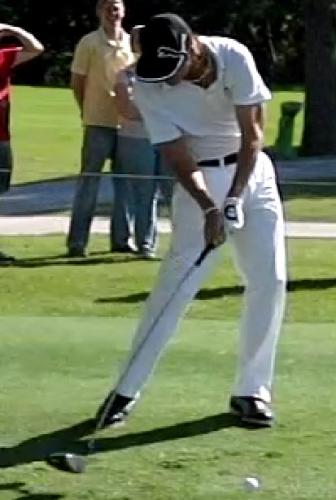
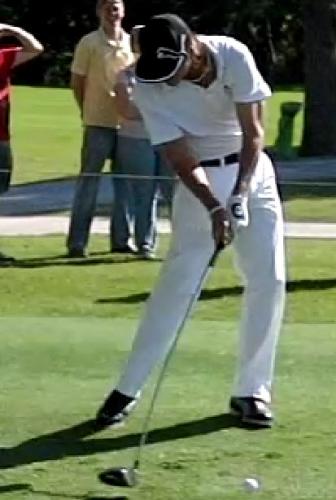
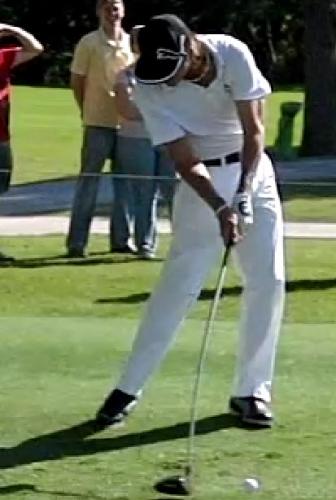
Notice in the last few frames prior to impact, Rickie loses all his lag angle.
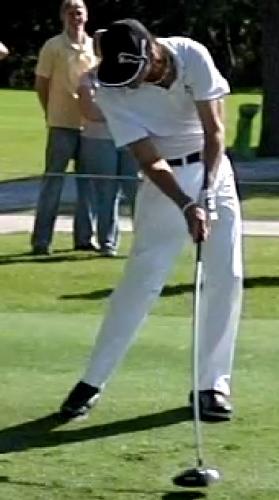
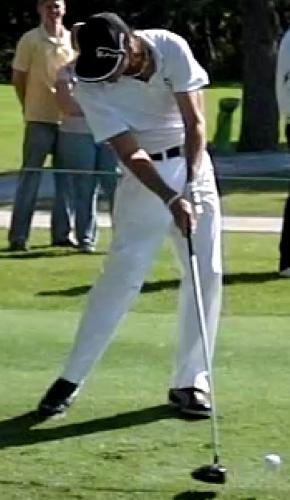
But instead of standing up, his head lowers and he uses his rhomboids and lats to pull the club through impact. This has a bit of a stabilizing effect on the hands, forearms and club and allows him to be far better than if he were to jump/stall. Thus, this type of flip should be called a flip’n drag release. They are squaring the clubface with left wrist extension/right wrist flexion but the pull from the torso rotation stabilizes the arms through impact to retain control of the club and clubface.
Contrastingly, the amateur flipper tends to stall the body while their right hand continues to flex and completely let the kinetic chain snap through.
Pro Underflip – Late LWE/RWF
Adam Scott, with a strikingly similar looking swing to a young, great Tiger Woods, is not so comparable when looking at his release pattern. He uses the pro underflip method to strike the ball.
If you look carefully at his hands prior to contact there is some LFS/RFP but right at impact he stops and releases the right hand under (flexion) while cupping the left wrist (extension). Thus, one frame after impact, the club shaft has already passed his hands.
This is not an active drive/hold release as Tiger employed in his heydays. This is a passive allowing of the club to overtake the left forearm without any clubface rotation thereby reducing the chance of hooking at the expense of some distance and added spin. The timing and acceleration of the underflip is critical since too early could lead to hooks or too much added loft/spin. Therefore players using this method are keenly aware of their rhythm and tempo which becomes their strength. The only drawback is they typically cannot or maybe will not take a full rip at a shot whereas the drive/holders like a young Tiger could find an extra 20 yards when necessary.
This is the same release pattern as Martin Kaymer and Mark Wilson use. Also, this was Nick Faldo’s release pattern and perhaps explains why a 6’ 3” tremendous athlete averaged 270 yards off the tee. He was tremendously accurate but when Tiger showed up at the Masters hitting 9 irons and wedges for his second shot into par 5’s while he was hitting 3 or 4 irons, he knew his days of dominance were over.
http://www.youtube.com/watch?v=YHXmfcygnV8
These two methods have proven to be successful at the highest levels since Goosen, Oosthuizen, Kaymer and Faldo have many major titles between them. The only drawback with the flip is if you want to hit the ball longer (Ian Baker-Finch).
Left Shoulder External Rotation
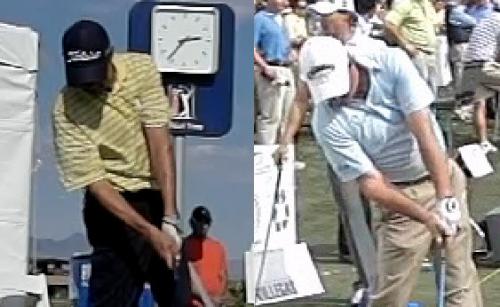
Notice the left elbow position of Davis Love III vs Graeme’s. Both of these are one frame post-impact to show how different the movements really are. Davis is rotating his left shoulder externally to help close the clubface. Not too many players with a standard strong grip who do this. Thus, while this is most frequently taught, this is a rarity amongst tour players.
Instinctively, the tour players have gravitated toward G-Mac’s move to stabilize the left shoulder for impact by retaining the internal rotation. I say “instinctively” because this is not commonly taught.
Combo #1 – Left Shoulder external rotation with early LWE/RWF
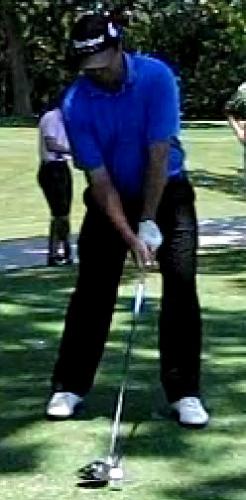
flipper
So here’s an unknown tour player from the Colonial event earlier this year with his strong grip.
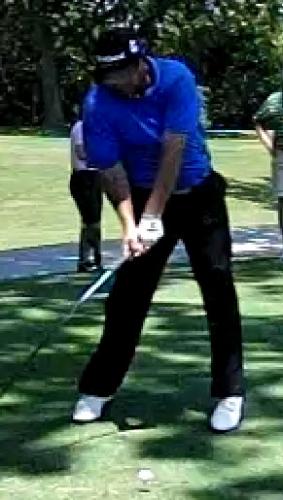
Notice at this position, his left wrist begins to extend (cup) and the right wrist starts to flatten.
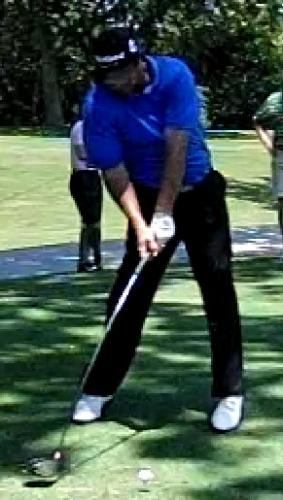
By impact you can see how his left wrist is cupped and forearm is pronated. He is also using the same left shoulder external rotation to help rotate the clubface that Davis uses. This complicates matters. This could introduce hooks if you can imagine. Of course he could ensure that he only underflips with the clubface open through impact but this would increase spin and loft while decreasing distance. Sound familiar?
Also, he loses his posture and jump/stalls prior to impact. This pattern is very common in the amateur ranks and should really be called the Jump/Stall/Flip swing because the three flaws come together in a nice package.
The reason for this is the early release of the left wrist (extension) causes the bottom of the swing arc to be behind the ball causing fat shots. This is typically compensated for by one of three Band-Aid fixes; excessive slide of the entire body toward the target (stack and tilters), chest covering the ball (upper body lunge used by Leadbetterites) and the stand up/jump move employed by many amateurs.
These three fixes all cause a stall, therefore even more flip and thus the merry-go-round starts and it’s hard to get off the ride.
Here’s a stack and tilter Dean Wilson that uses left shoulder ER + LWE/RWF to hit the ball. Has a little underflip because of it. Also uses the full body slide method to avoid the fat shot.
Combo #2 – left shoulder external rotation with LFS/RFP = Rollin’ Rollin’ Rollin’
Phil
Phil Mickelson uses his lead shoulder external rotation and lots of LFS/RFP to help square the clubface as I have pointed out in an earlier article. The added effect of the shoulder external rotation is to allow more and faster rotation vs. keeping the lead shoulder in internal rotation and rotating the forearms alone. While this might be hard to get timing right, it could be worse if he had a weak/neutral grip.
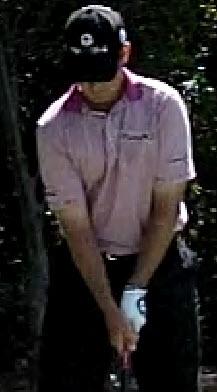
low hook
straight
Here’s a close up of a roller, Hunter Haas’ clubface movements through impact with his weak/neutral grip. These were two consecutive shots during the practice round. The first shot wasn’t good so he hit a second ball.
Now look at how the hands moved through impact. Can you see LFS/RFP and along with left shoulder ER? There’s so much rotation of the hands through impact. The weak/neutral grip makes it harder for him to drive/hold a stable position through impact. As the forearms approach the end of their range of movement in terms of supination/pronation, they become more unstable. It will either work toward a little radial deviation (like a topspin in tennis) to create an occasional hook or move toward an underflip to keep the clubface from closing too much.
Compare Hunter’s vs. Trevor’s hands/forearm positions. Trevor is not near the end of his range of motion. He can supinate/pronate more and still retain a stable, square clubface.
Combination #3 - LFS/RFP with LWE/RWF
One major issue of a neutral/weak grip is that the clubface needs to be closed more than for a golfer with a strong grip as I showed with Johnson Wagner. So some players must use both LFS/RFP and LWE/RWF in order to square it. But this further complicates matters.
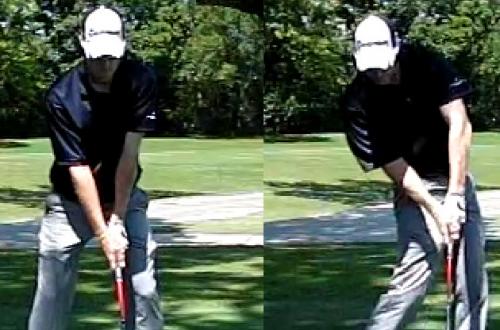
Notice the two methods being used to square the clubface.
Meanwhile in Opposite World...
Confucion Says
When famous Far Eastern (Florida) Swing Philosopher Confucion utters words they are written in stone and must be adhered to if you are to achieve golfing Nirvana. Here he was at the 2011 Accenture in February demonstrating to Sean O’Hair how to use LWE/RWF to hit the ball.
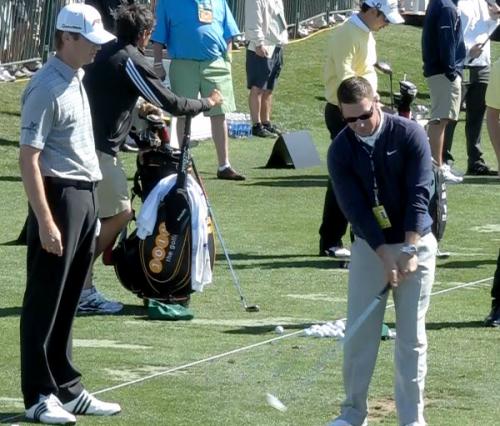
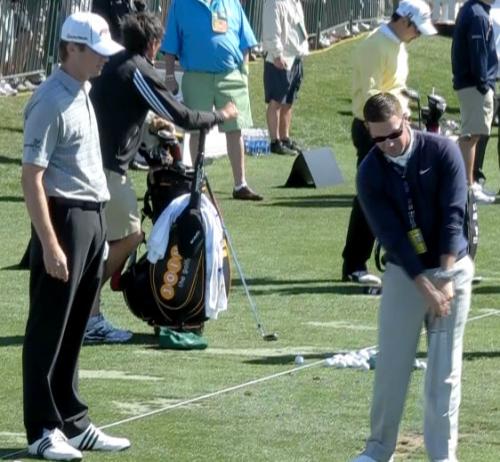
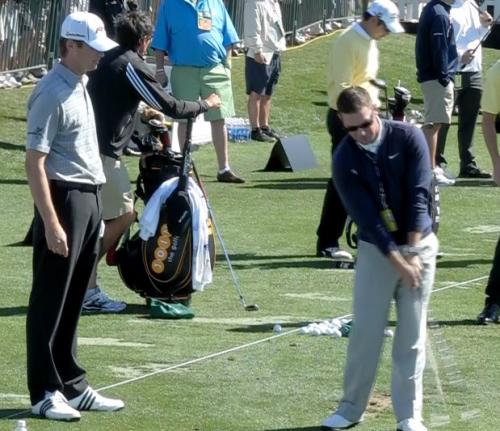

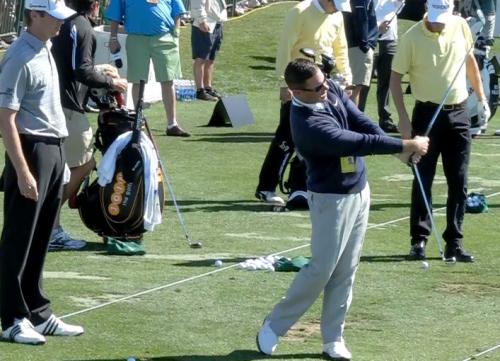
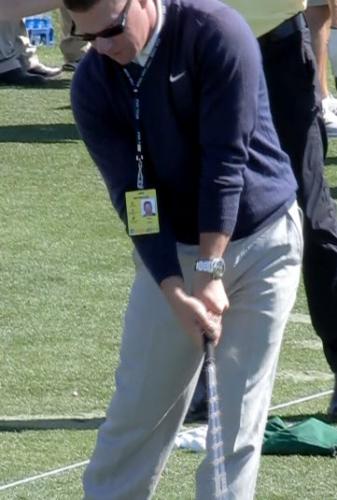
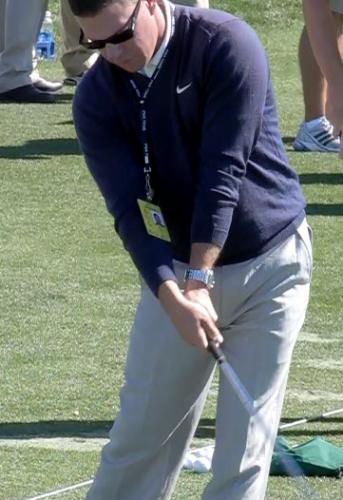
“A flip you must do!”
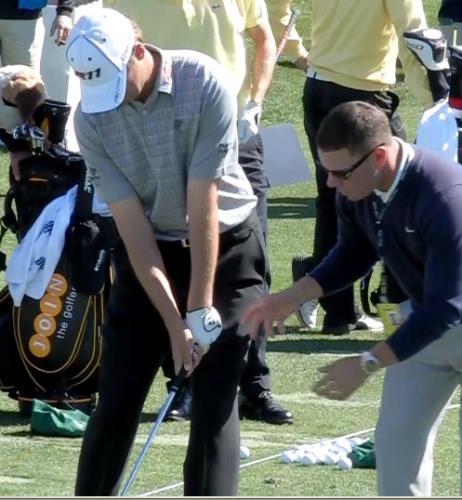
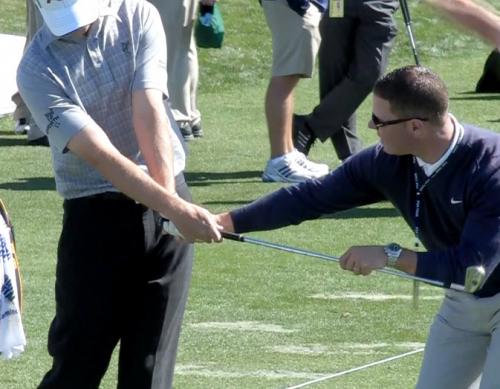
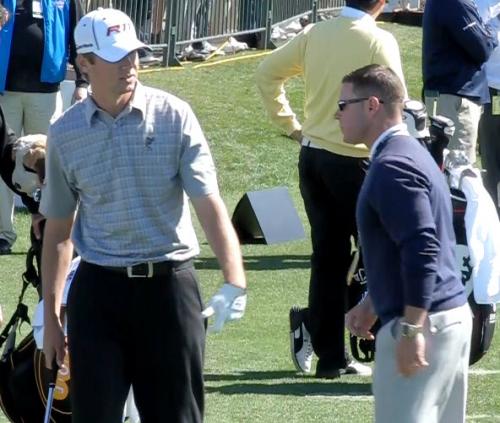
To be sure, he put O’Hair in these positions so there is no doubt that this is what Confucion wants him to do. So look at O’Hair’s wrist positions. His right and left wrist is in extension at the impact position. Also both forearms are pronated. Then post-impact, be sure to flip it. Would that, could that even work??? That would leave the clubface too open given his neutral right hand grip...
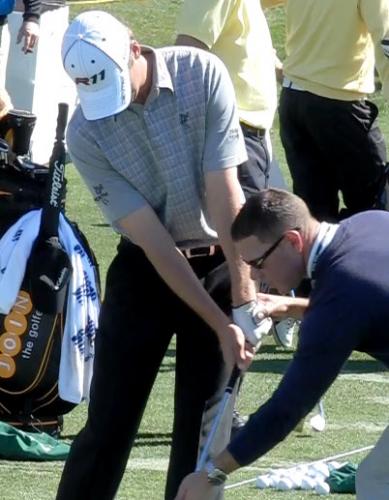
So here’s the athlete’s body saying, “Illogical. Does not compute. I must supinate to square the clubface.” Notice O’Hair’s left wrist is supinated to match his right wrist extension/pronation. Also, Confucion does not notice that O’Hair is rehearsing left forearm supination after the sermon.
Finally O’Hair comes to his senses and stops the insanity. Here he is from June at the Crown Plaza Colonial event employing LFS/RFP and a bowed wrist drive/holding release pattern after parting ways with Confucion. Of course the Hollywood end to the story is that he won the Canadian Open last month to the delight of many fans.
Another Confucion Tale: He Who Flip Must Slide
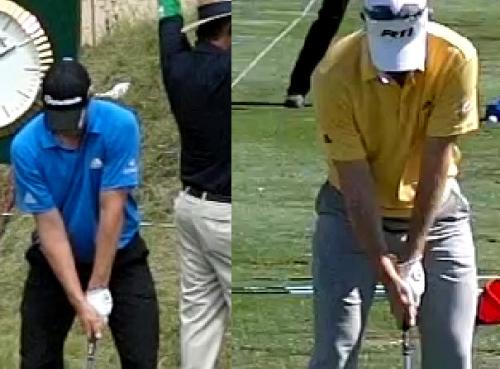
On the left is Justin Rose from the 2009 PGA at Whistling Straits. On the right is Justin from 2011 Accenture Match Play. Notice the strong grip he had (when he was winning) and how much weaker it is now. Does it make a difference? You be the judge (of course his recent play is also evidence).
On the left, Justin uses the LFS/RFP mainly to square the clubface while retaining some shaft lean at impact. On the right, Justin uses some LFS/RFP but also adds in more right wrist flexion/left wrist extension to “aid” in squaring the clubface. Why would anyone want to do that? Confucion says...
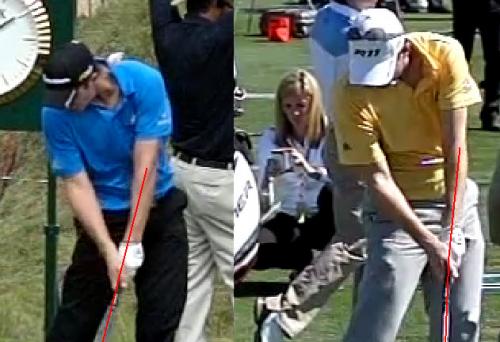
These two shots were with fairway woods. Notice that due to the added flip, his upper body has to slide more to the left at impact or he might hit it fat.
Mixed Plate: Swing like Mahan
Hunter
The odd thing about Conficion is that he says he’s trying to make everyone swing like Hunter Mahan. But Hunter is actually using more LFS/RFP than Rose or his own swing.
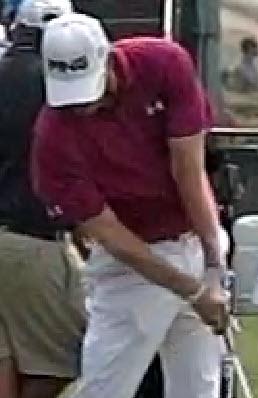
To make it even more complicated, Hunter is also using some left shoulder external rotation. Could it be that this swing is very difficult to copy? He’s using the mixed plate method. He’s got an early release of his lag angle that puts his left wrist in extension early (LWE/RWF), but then just before impact uses LFS/RFP and then left shoulder external rotation.
And this is what Tiger is trying to learn?
Weir(d) Flip
This was done right handed to avoid misunderstanding. Is it possible that this is caused by a strong left hand grip but a weak right? Mike Weir supinates his left hand but his right hand, instead of pronating, is supinating and moving toward flexion as well. Thus his hands are not working together. They are fighting each other. The LF supination is trying to close the clubface while the RF supination/flexion will open the clubface. Whichever wins will dictate where the ball will go. It’s a tossup.
Stronggripophobia Rx
High speed video has allowed everyone a deeper insight into the real world of how the clubface is moving throughout the swing.
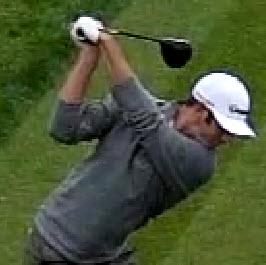
We’ve all seen Dustin Johnson’s bowed left wrist and closed clubface at the top of the backswing.
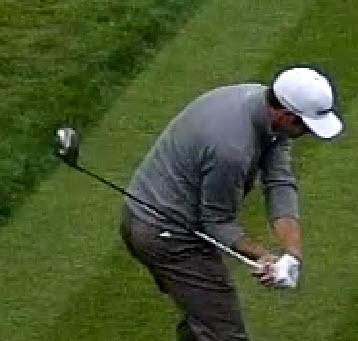
But did you know his left wrist slightly flattened halfway down to open the clubface? This makes him look similar to other players at this point.
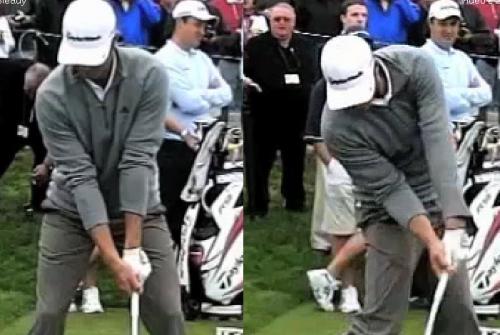
DJ uses a standard strong grip and looks like many other great players at impact.
See DJ’s hands and clubface move through impact. It looks very stable and repeatable with a lot of forward shaft lean for low launch and spin reduction in comparison to the flippers.
How Do Extreme Strong Grippers Hit It?
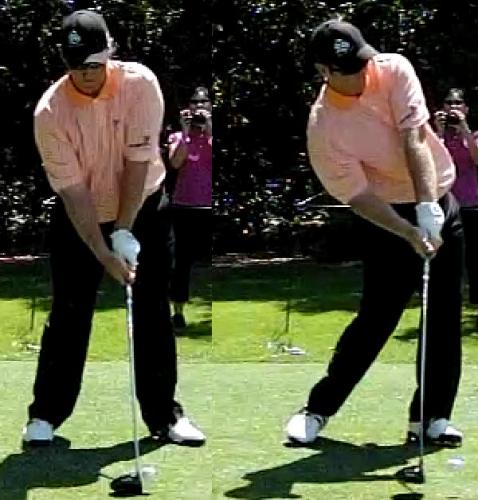
Here’s how David Duval, former #1 golfer in the world with an extreme strong grip does it. His left elbow at address might have been pointed slightly left of the target. At impact, it looks like it is pointed more to the target and higher up to the sky. Thus, he should hit the ball higher and more to the right but he counters those two clubface opening/increase loft factors with supination of the left wrist and right wrist pronation just as any strong grip player would do. He also has a good amount of shaft lean at impact to lower the ball flight and reduce spin. He does this with his right wrist which started in flexion (bowed) and right forearm supinated but at impact it is more extended (cupped) and pronated.
Perhaps, this may not look like he’s supinating since his left wrist is pronated at impact. But if you’ll think of how extremely pronated Duval was at address, then how much less pronated he is at impact; you’ll realize that there is supination or a movement toward a more supinated position. This is light years different than returning to the same extremely pronated/flexed position at impact!!!
Prehistoric days of teaching
High speed video has changed the understanding of what really occurs with the clubface during the golf swing. Prior to high speed video, if you were hooking, the clubface must have been too closed at the top and therefore your grip too strong. No one really knew how the clubface was moving in the impact zone nor did we know what the hands were doing either. Everyone just assumed what was going on. Yet, it is far more complicated than just where the clubface is at the top.
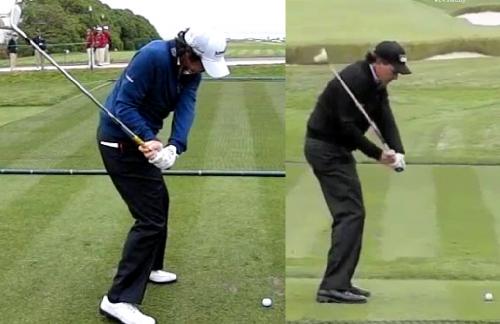
Look at the different clubface positions of Rory vs. Phil. The once-invisible world of the clubface can now be seen and the ideas we once had need to be re-examined. For example, Phil Mickelson’s clubface is too open throughout the downswing (due to locked up spine and limited lateral bend). Notice the different positions of the right hand (actually Phil’s left since I’ve reversed the image).
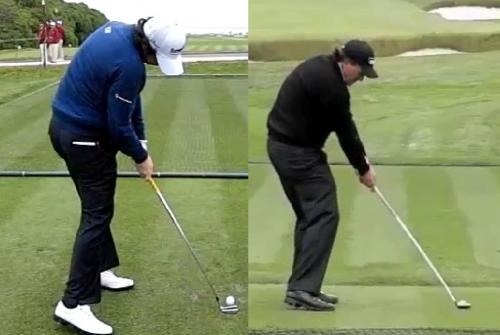
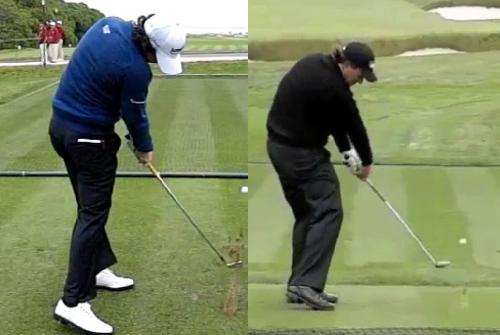
Thus he must roll his hands fast (or flip which he doesn’t) or else the ball will go left (lefty). If he does this too fast, it will hook. Contrast to Rory’s more stable position post-impact. His left wrist hasn’t rolled like Phil’s.
Or look at how stable Dustin’s hands are through impact. See any rolling like Phil?
The previously invisible world shows how the clubface being open causes a flip, roll or both to occur. The great many tour players with strong or extreme grips and do not need to roll or flip because they have enough movement available to square the clubface via LFS/RFP without nearing the end of their range of movement.
The World in 3D
The hands/wrists are capable of a wide range of motion from up/down, side to side as well as circumduction (circular movement). They are also tied to forearm movements of supinatin/pronation. It is not as Martin Hall said on the Golf Channel “instructional” program. He put hinges on his left and right wrist and said the left wrist only moves in radial/ulnar deviation while the right hand only moves in extension/flexion. If it were only so simple! This type of oversimplified instruction might work for a tour player because they fill in the blanks athletically. But would it work for the average golfer? Highly doubt it since adults learn more analytically, we need correct information, logic and full understanding. Instead of teaching “A and Z” golf instructors need to teach “A to Z.”
To understand the wrists and forearm movements better, try this at home. Grip the club in your address position then try to do these test movements:
- LFS/RFP only – you will automatically move toward radial deviation on both hands AND left wrist flexion (bowing) and right wrist extension (cupping).
- LWE/RWF only – you will automatically move toward left forearm pronation/right forearm supination AND ulnar deviation.
See how these movements cannot totally be separated once your hands are on the club? Both of these movements will also cause the club to flip past your hands. Since we’re not interested in learning how to flip better we won’t worry about LWE/RWF. So how will you use LFS/RFP without letting the club pass your hands?
- LFS/RFP with UD – as soon as you start to develop UD, you will automatically get left wrist flexion/right wrist extension. Also, the hands will stay ahead of the clubhead while squaring the clubface!
Once you get the hang of it, try matching your movements to a desired shaft lean angle. Try marking an angle of 15 degrees forward shaft lean on a mirror. Then do your movements from halfway down on the downswing, trying to retain your lag, then return to square holding your 15 degrees of shaft lean and LFS/RFP/UD. It might be helpful to put a piece of tape on the ground to ensure square clubface at impact.
As you have seen, most of the tour players are using similar movements to a young Tiger who used LFS/RFP to square the clubface. Tiger’s clubface may have been a bit closed at the top during his best years and while some experts believe that is wrong, how could it be wrong when his clubface is square to slightly open now but isn’t winning majors by 12 or 15 strokes? Perhaps, having the clubface a bit closed at the top means less closing to perform at impact? And as we have seen, the more the clubface is open, the more apt you will be to employ combo methods to close it by impact thereby making your release pattern more complex.
So learn a strong grip as detailed in the previous article and practice the LFS/RFP/UD like in the moves of the Impact Snap Device and learn to rotate your body and develop lateral bend so that a jump/stall does not force you to extend your right arm too early and cause a flip.
Notice how all the players with great impact positions have their heads lower and away from the target than at address. Of course the flippers must lift up or lunge forward to avoid the fat shot. So be sure you’re working on that at the same time so you can fix the two problems at the same time.

